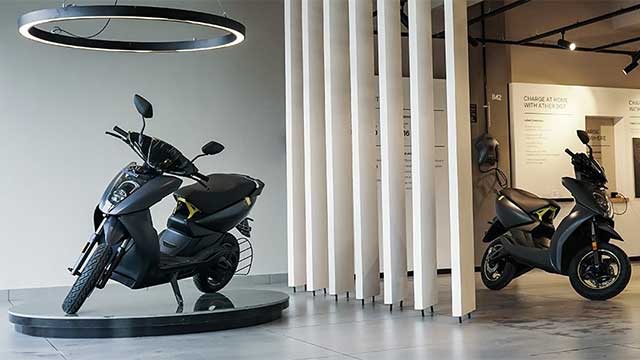As the world celebrates Earth Day, Ather Energy, India’s leading electric scooter brand, today released a report showing the environmental benefits of EVs compared to internal combustion engine (ICE) scooters. The report released by Ather Energy is based on an earlier study of the carbon emissions of a 110-cc ICE scooter conducted by The International Council of Clean Transport (ICCT) to an EV scooter with a 2.9 kW battery, in this study – the Ather 450X. The report analysed all-encompassing phases, including mining, battery and vehicle production, well to tank, tank to wheel, and recycling. In India, 110cc scooters sell well over 2 lakh units a month and have the highest share in the two-wheeler category.
The report shows a staggering 38% reduction in carbon emissions over the lifecycle of an electric scooter compared to a 110cc ICE scooter. In this report, Ather Energy has also factored in a replacement battery pack to the ICCT report. Even then, the resulting lifetime emissions from an e-scooter accounting for 2 battery packs would still be 35% lesser than a 110 cc scooter. Based on the exhausted battery pack’s condition, the report factors that the depleted battery pack may be recycled or used for energy storage applications.
Commenting on the report Tarun Mehta, CEO, Ather Energy said, “This report is an attempt to highlight and reiterate how electric scooters are a clear upgrade over ICE scooters, not just in performance and ownership but also environmentally. Electric vehicles are the single biggest hope for achieving a decarbonised world and faster adoption of EVs is the first step towards this goal. In our country, the transition to sustainable modes of transportation has begun well, largely led by electric two-wheelers. While our nation has taken great strides towards e-mobility, the electric two-wheeler fleet needs to grow much more rapidly in emerging markets. On the occasion of Earth Day, I urge more people to join the electric revolution for a cleaner tomorrow.”
Taking inspiration from insights from the ICCT report, Ather energy has worked out the reduction in emission in comparison with a 125cc scooter for various scenarios. While the ICCT paper accounted for emissions from the manufacturing of only one battery pack during the lifetime, Ather has accounted for an additional new battery pack installed as a replacement battery. The report further takes into consideration another scenario with the instalment of solar grid for charging of vehicles. Using the ICCT as a guideline where Ather 450X is representative of the EV, the company revealed that it has saved 56,31,000 kg of CO2 in 2022 alone, under present-day calculations.
The report addresses common misconceptions that continued dependence on fossil fuels makes the electricity grid a stalemate since the CO2 emissions from the grid to charge the batteries negate the benefits of zero tailpipe emissions. It points out that the country’s current weighted average emission factor for the national grid has been nearly constant over the past few years, comparable to Poland’s, which is also largely dependent upon coal for its electricity. Assuming EVs in Poland are using their country’s grid to manufacture and charge their batteries, CO2 emissions are seen to be ~29% lower than average emissions from both diesel and petrol, with expectations to fall to close to ~50% by 2030.
In terms of efficiency, EVs convert around 60% of the electrical energy from the grid to power the wheels, while petrol or diesel cars convert only 17%-21% of the energy stored in the fuel to the wheels. This means that around 80% of the energy stored in petrol or diesel is wasted, while EVs are far more efficient. The report further cites that EVs can reduce carbon emissions by up to 85% compared to a 125-cc ICE scooter when powered by renewable energy produced through solar grid installed at home.
Two-wheelers dominate total vehicle sales in India, and if no fuel consumption standards are put in place and the proportion of electric two-wheelers remains negligible, then tailpipe CO2 emissions from India’s two-wheeler fleet alone are projected to reach 120 megatonnes by 2050. An analysis of air quality in New Delhi in 2018 showed that the transport sector accounted for 19%, 39%, and 81% share of annual PM10, PM2.5, and Nox emissions, toxic gases that cause respiratory ailments. The report reiterates the urgent need to transition to EVs for a cleaner tomorrow and how policymakers need to take immediate action to support the electrification of the two-wheeler segment to stay on track for net zero by 2050.




